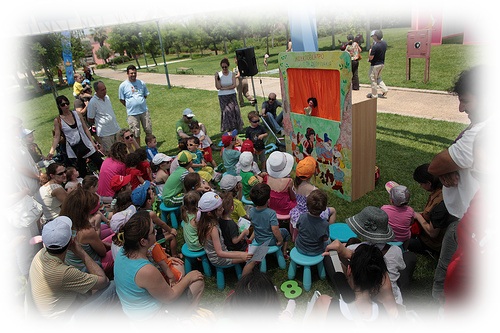How to make storytelling interactive
Thanks to a recent reader question about what techniques are there for making stories interactive, I have a new article to publish for the first time in ages! Thank you whoever you are for asking me and I hope this answers your question (sadly their supplied email address bounced).
Making stories interactive is an interesting topic and one I try hard to do all the time. In the purest sense, you can make your stories interactive by delivering them in an engaging way.

Using facial gestures, tones and moving about, you keep your audience interacting with you: watch their faces, their body language and eyes because they’re telling you that they’re involved (or not) in your story.
Some articles on interactive storytelling
If you want to get them physically involved and “interacting” with the story, then check out the following two articles and try out some of the suggestions:
http://kidmunication.com/
This article is all about the concept of story sacks: a “sack” or bag containing props and devices relevant to the story that the children can bring out to use at certain relevant points during the story.
http://kidmunication.com/
Story cubes are effectively picture dice invented by a clever chap in Ireland and which is now doing extremely well which is awesome. Roll the dice and use the pictures to create a story between you. We took some on a family holiday earlier this year and kept us amused and quiet (well, apart from the occasional squeal of delight from my daughter) on the plane on the way out.
Top ideas for making your stories interactive
Other ways you can get your audience involved:
- Ask them what happens next! They’ll give you something and you can work that into the story. Start with characters’ names and then move on to items, then events and emotions.
- Play games like Chinese whispers to help children discover how a story can evolve from a simple sentence – people love stories and we like things to be in a nice narrative order so start the whisper with something that is not straight forward to understand or is out of context – those that don’t hear it quite right will fill the blanks with stuff that makes sense in a narrative format.
- Dress up. Get the kids to dress up and play characters from the story. For older children, you could even get them to act out the parts.
- Also for older children, you can get them to read character’s lines from a book and then encourage them to use some of the story telling techniques you know to bring it to life rather than read dead-pan from the book.
- With younger kids who can’t read yet, try giving them musical instruments or sound producing things that they can shake, rub, rattle or blow to indicate various things happening in the story (wind blowing in the trees, the bark of a dog etc.)
- If you have a small group, you could take them on a story walk and take them around a location telling the story as you go and winding bits of the things and places you see on the walk into the story. Think of tourist walking tours in places like London where you can have a “Ghosts of Whitechapel” walking tour.
- If you’re reading to your child in bed, you can give them a squeeze at the right moment or grab their toe when the stinagling starts climbing up their leg.